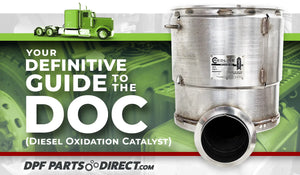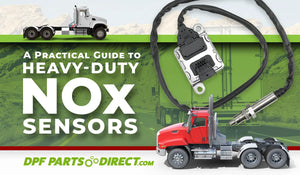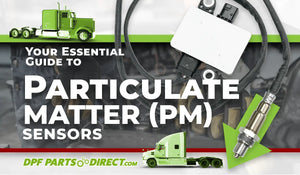
Owner-operators play a critical role in keeping the country moving by transporting goods and services. Despite your importance, idling remains a major issue for the trucking industry, especially during the winter months when idling rates are at their highest. Idling not only costs you more in fuel, but it also produces more emissions and accelerates the wear rate of critical engine systems like the aftertreatment system.
In this article, we'll explore the impact of idling on your business, the benefits of reducing excessive idling, and strategies you can implement to reduce idling. Don't miss this opportunity to learn about how you can improve your bottom line and contribute to a cleaner environment.
Reduce Idling for Owner-Operators: Fuel, Maintenance, and Emissions
As an owner-operator, you know that fuel costs are a significant expense for your business. Did you know that idling your heavy-duty truck can greatly increase fuel consumption and reduce fuel efficiency? Not only does idling consume fuel without propelling your vehicle, but it also produces emissions that contribute to air pollution.
In addition to the environmental impact, idling can also cause accelerated engine wear and tear on critical engine systems, such as the aftertreatment system. This system removes harmful emissions from the engine, and idling causes it to work harder, reducing its lifespan and increasing maintenance costs. These added costs, combined with reduced fuel efficiency and decreased productivity, can negatively impact your bottom line.
Consider this example: idling for just five hours a day during the winter can consume over 1,000 gallons of fuel and produce over 8,000 pounds of emissions for a single truck. And don’t forget the impact on driver productivity, as they spend more time waiting for the vehicle's engine to warm up instead of driving.
Reducing idling is a smart business decision that can improve your fuel efficiency, reduce maintenance costs, and minimize emissions.
Reduce Idling to Lowering Costs & Improving Idling Diesel Truck Efficiency
Owner-operators understand the importance of maximizing their profits while maintaining a green, eco-friendly image. That's why idle reduction is crucial in heavy-duty trucking fleets. By reducing idling engine time, you can save on wasted fuel expenses and decrease emissions - a win-win for your bottom line and the environment.
Moreover, reducing idling also lessens wear on critical engine systems like the aftertreatment. Long periods of idling cause motor oil to break down, leading to more wear and tear on the engine and its components. Additionally, idling contributes to the buildup of soot and other contaminants in the aftertreatment system, reducing its performance and increasing maintenance and cleaning needs. By reducing idling diesel truck efficiency, you can minimize wear and tear on your engine and aftertreatment system, improving reliability, lowering maintenance costs, and boosting overall vehicle performance.
In addition to the environmental and economic benefits, idle reduction can also increase driver productivity. Drivers spend less time waiting in their trucks for the engine to warm up during winter, freeing up more time for driving and delivering.
Reducing idling is a smart investment for owner-operators. By taking idle reduction seriously and implementing strategies to cut down idling, you can improve your fleet's efficiency, reliability, and profitability, while also doing your part for the environment.
Reduce Idling With These Technologies & Strategies

Several technologies exist for heavy-duty trucks to lower idling and enhance diesel fuel economy. The auxiliary power unit (APU) is one such technology. It provides energy to the truck's electrical and climate control systems while the engine is turned off, thus reducing idling. APUs can be powered by batteries, diesel, or propane.
Idle reduction systems are another technology that can help. They shut off the engine after a designated idling period and restart it as needed. These systems can be set based on the truck's battery state, temperature, and other relevant factors to minimize engine operation. Engine and battery management systems are also helpful in reducing idling by optimizing engine performance and cutting down the time required for the engine to idle to keep the battery charged.
By utilizing these technologies and others, trucking fleet vehicles can significantly lower their idling and boost fuel efficiency, as well as reduce emissions and operating costs.
Reduce Idling With Education & Training
Additionally, proper training and education for truck drivers play a crucial role in reducing idling. One such example is the Idle Free for our Kids program, which offers an idle reduction training program to truck drivers.
This program aims to reduce idling in the trucking industry, particularly around schools, by promoting knowledge and skills that help drivers reduce idling and fuel consumption. Through this program, drivers receive training and education on the importance of idle reduction and practical techniques to reduce idling in their daily operations.
The program also provides trucking fleets with information and resources to implement idle reduction technologies, such as auxiliary power units (APUs) and idle reduction systems, and how to optimize their use to improve fuel efficiency and decrease idling.
Idle Free for Our Kids: Education for Truck Drivers
Studies show that the Idle Free for our Kids program has made a positive impact on reducing idling and improving sustainability in the trucking industry, especially around schools. Through education and training, the program has equipped thousands of truck drivers with the knowledge and skills to reduce excessive idling, leading to improved air quality and reduced emissions in local communities.
The program's combination of driver education and support for idle reduction technology implementation has proven to be an effective solution for reducing idling and improving the trucking industry's overall sustainability.
However, some truck drivers may be resistant to reducing idling due to habits or misunderstandings about the benefits. They may view idling as a source of comfort or convenience, or be skeptical about the economic and environmental impact of reducing idling.
To overcome this resistance, trucking fleets must educate their drivers on the benefits of reducing idling and provide them with the necessary tools and resources. This includes offering training programs like the one offered by Idle Free for our Kids, providing educational materials, and offering access to technology that makes reducing idling easier and more convenient for drivers.
Reduce Idling This Winter
Winter can be tough for heavy-duty truck drivers, but reducing idling is one way to mitigate its challenges. By avoiding excessive engine revving and idling, owner-operators can cut down on fuel costs, lower emissions, and extend the lifespan of their equipment.
Implementing auxiliary power units, idle reduction systems, and providing proper training and education are all effective strategies to achieve this. At the same time, these efforts will contribute to a cleaner environment and a stronger bottom line for the trucking fleet. Prioritize idle reduction and put these strategies into action today.

Here at DPFPartsDirect.com, we care about your bottom line. This article was researched and written by our team to help you reduce your total cost of operation because we support truck owners and drivers throughout the U.S. and Canada.
Our online superstore offers the best prices and the biggest selection of high-quality parts to keep your truck on the road. Contact Us today and check out our other blog posts to learn more about reducing costs and maintaining your equipment.










Comments 0